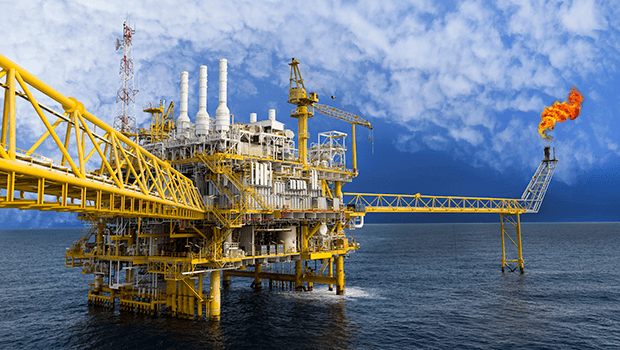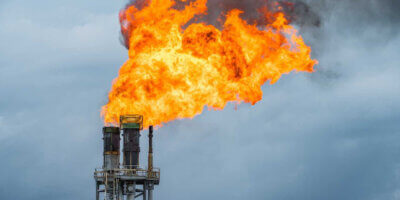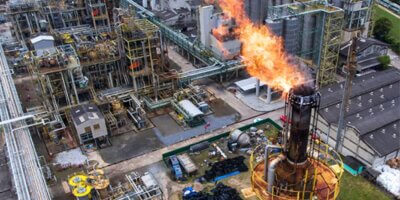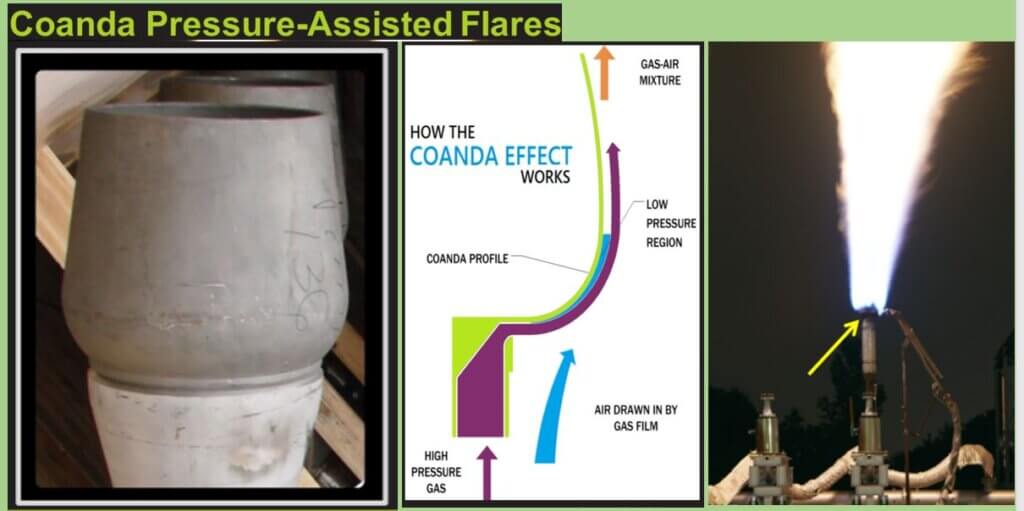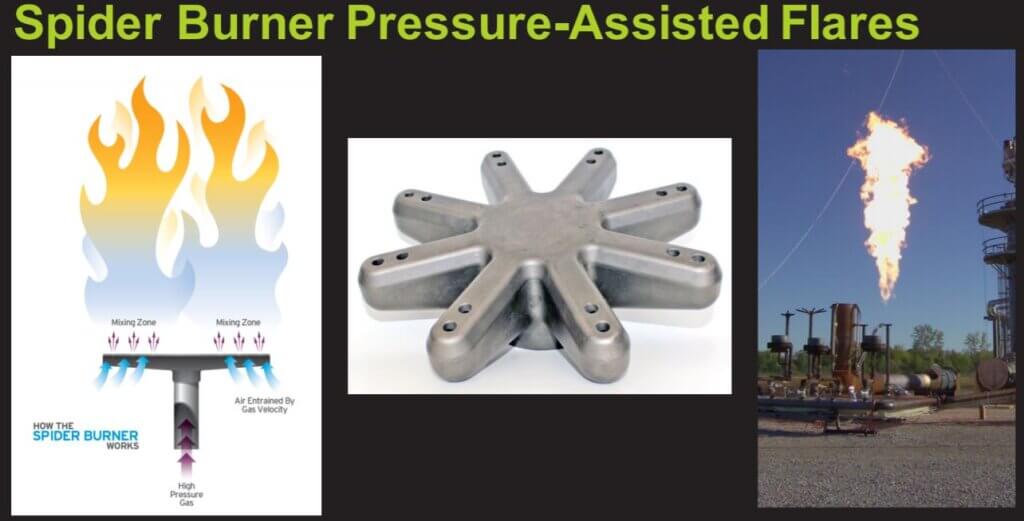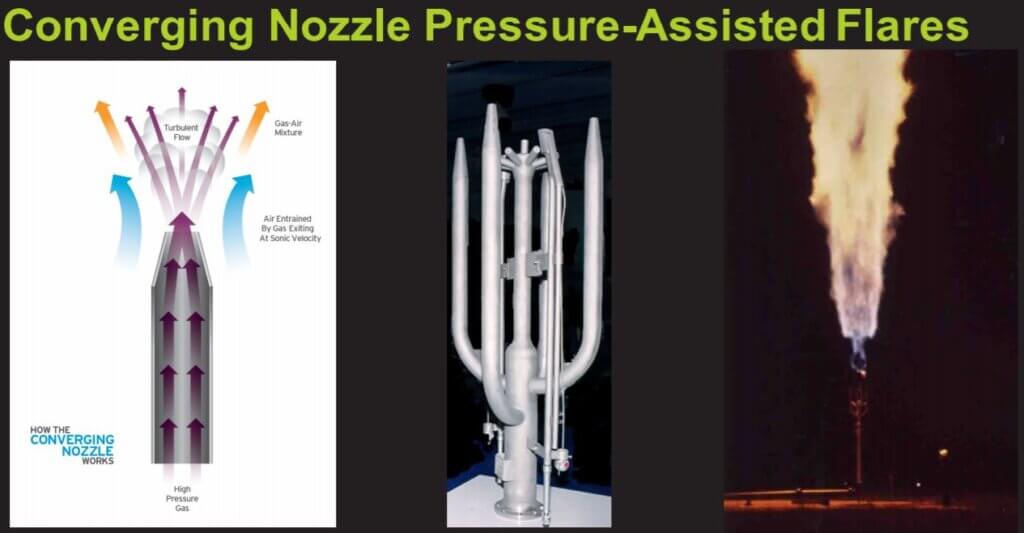THIS IS PART- Ⅱ OF A SEVERAL PARTS ARTICLE SERIES ON FLARE SYSTEM. CLICK HERE FOR PART-Ⅰ
Based on the height of the flare tip, flares can be categorized into two types- Ground flare and elevated flare.
Ground flare
A ground flare is where the combustion takes place at ground level. It varies in complexity and may consist either of conventional flare burners discharging horizontally with no enclosure or of multiple burners in refractory-lined steel enclosures. Ground flare is the preferred choice only if a plant is located in an area where it is highly desirable to have a flare which is not visible to the public.
Ground flare are mostly of two types – open ground flare and enclosed ground flare.
Open ground flares
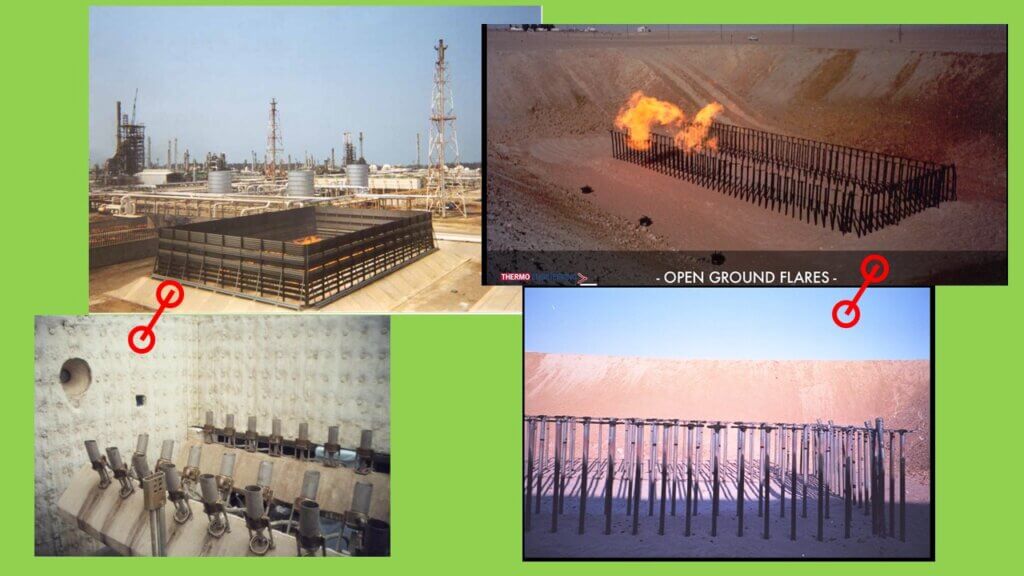
Here flare headers distribute and the flaring occurs at ground, with the area surrounded by radiation fences. Most have multiple burners that combine to flare large amounts of gas. The burners are located either in a refractory lined enclosure or in an open pit. Some open pit ground flare also utilizes either a series of burners standpipe-mounted on underground pipe manifolds. open ground flare can combust larger quantity than enclosed flares. Another type of ground flare is the horizontal flare which is located in an open pit.
Enclosed ground flares
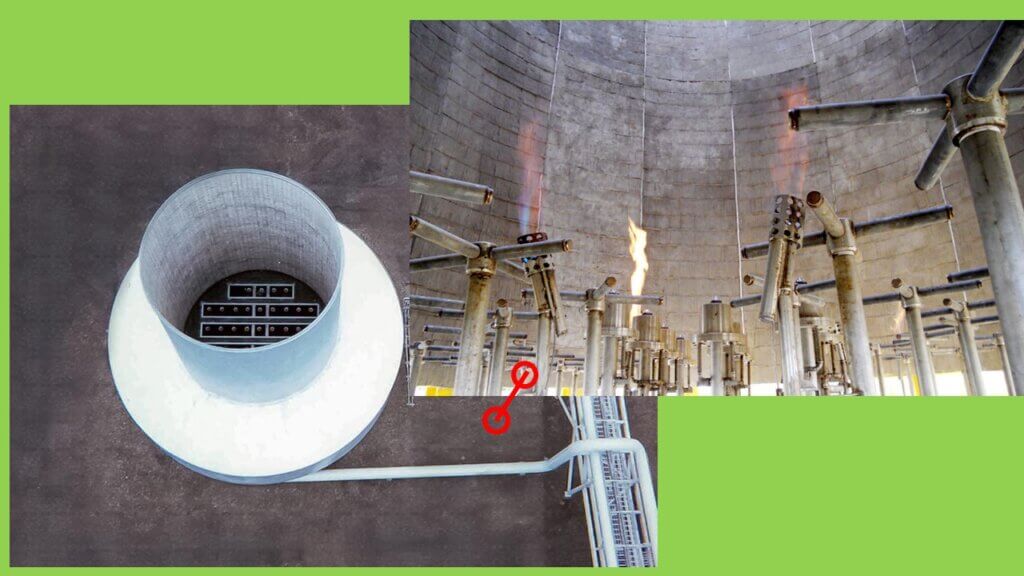
Enclosed ground flares are the most practical ground flare type for industries located in the city areas. While they are expensive, they provide a means of smokeless combustion without a flame visible to the surrounding area. Hot combustion gases from an enclosed ground flare are discharged to the atmosphere through an opening at the top of the refractory-lined enclosure.
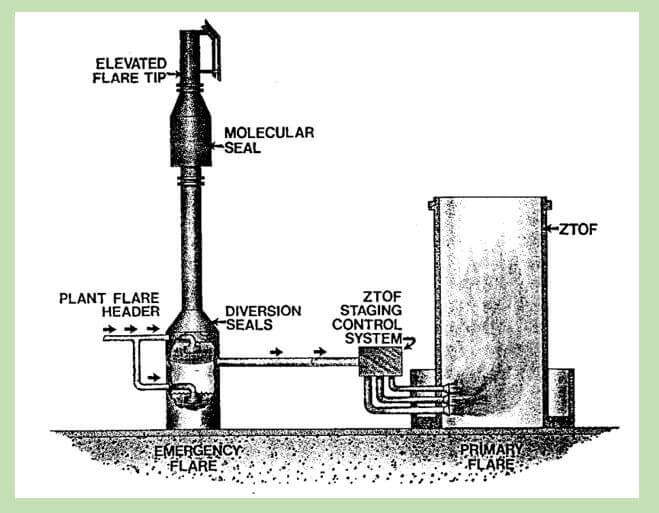
A typical enclosed ground flare installation is shown in above figure . Vapor loads normally pass through the low-pressure seal and to the enclosed ground flare where multiple small burners are used to combust the vapors. These burners are divided into groups which are activated (staged) via control valves, with additional stages opening as header pressure increases. Since only the first group (stage) of burners is operating continuously, purge requirements for enclosed ground flares are based on maintaining a required flow through those burners only. When a major upset occurs, pressure rises in the header to the point where flow passes through the liquid seal to the emergency elevated flare which is sized to handle the worst-case flaring contingency.
Enclosed flare systems come in both natural and forced-draft types. Usually, the combustion chamber is a steel structure lined with refractory material. Most of the units are temperature-controlled with sample ports available for measurements.
Elevated and ground flares used at sites can be further classified into two types: single-point and multi-point flares. Single-point flares are typically oriented to fire upwards. Single-point flares can be smokeless or non-smokeless using air-assisted or steam-assisted designs, and are suitable for low-pressure applications. Multi-point flares are designed for higher-pressure applications and where smokeless burning is required. Multi-point flares are used to improve the burning by applying multiple burning points. These can be located on the ground level or at an altitude using boom supports.
Below is an animation for multi-point ground flares.
Elevated flares
For safety reasons it’s a advantage to have flares at considerable height from ground. Elevated flares are preferred over enclosed ground flares due to lower costs. Elevated flares are also preferred over open pit ground flares due to lower land requirements.
Type of flare supports
Elevated flares for onshore facilities can be supported in three ways as mentioned below
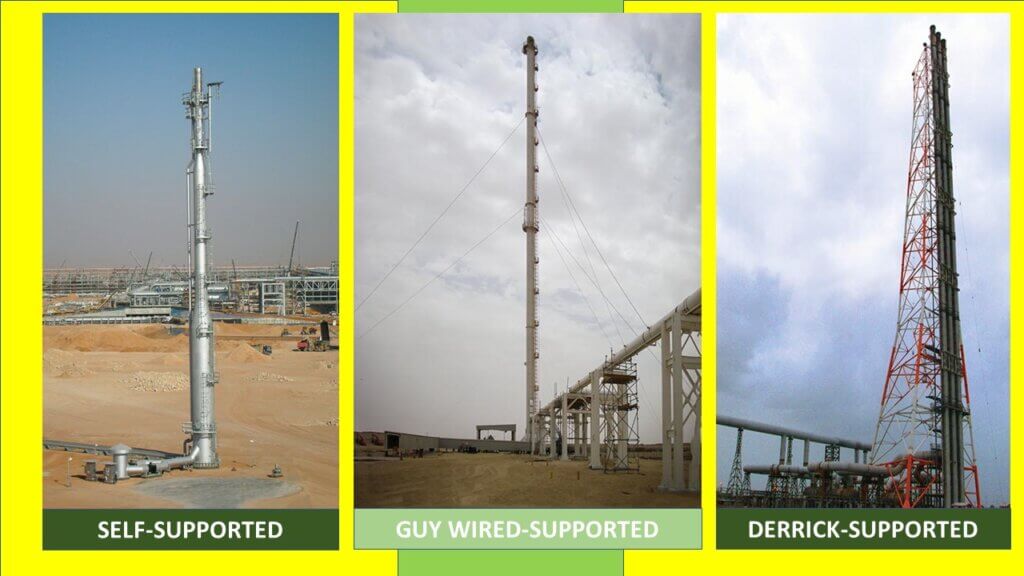
Self-supported flares
The self-supporting stack is a freestanding stack anchored to a base. Self-supported flare system is used for lower heights when radiation exerted is low. It uses less space for installation. Self-supporting flares are generally used for lower flare tower heights 9mtr to 30mtr but can be designed for up to 75mtr.
derrick supported flares
The derrick-supported stack is located in the center of a derrick structure and is held to the structure by tie rods and guides. Derrick-supported flares can be built to a considerable height since the system load is spread over the derrick structure. Derrick supported flare system is optimum installation for higher heights where high radiation is exerted. This design provides for differential expansion between the stack, piping, and derrick. Derrick-supported flares are the most expensive design for a given flare height. The derrick-supported stacks have been built for around 120mtr height.
Guyed stack flare
The guyed stack is anchored by guy wires. The guy-supported flare is the simplest of all the support methods. However, a considerable amount of land is required since the guy wires are widely spread apart. Guy rope supported flare system is used when toxic gases are burned at medium height. A rule of thumb for space required to erect a guy-supported flare is a circle on the ground with a radius equal to the height of the flare stack. These have been constructed up to height of 180mtr.
For flare stacks higher than 180 meters, a concrete support structure is required.
The structural support systems for elevated flares in offshore facilities are the boom-supported and derrick-supported. The flare may be either vertical or inclined. The boom is an inclined support structure consisting of tie rods and guides.
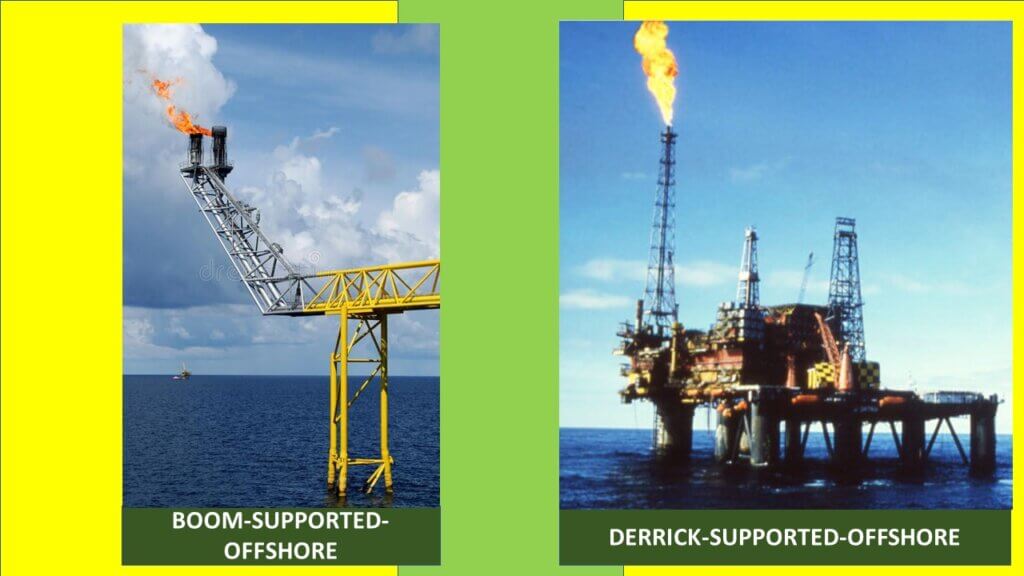
Type of flare based on mixing at flare tip
As in all combustion processes, an adequate air supply and good mixing are required to complete combustion and minimize smoke. The various flare designs differ primarily in their accomplishment of mixing. Based on the method of enhancing mixing at the flare tip, the flares can be categorized into four types as stated below:
Steam-assisted flares
Steam-assisted flares are single burner tips, elevated above ground level for safety reasons, that burn the vented gas in essentially a diffusion flame. They reportedly account for the majority of the flares installed and are the predominant flare type found in refineries and chemical plants. Steam assisted flares are designed to dispose of heavier waste gases which have a greater tendency to smoke. In order to prevent incomplete combustion, steam is injected into the waste stream using peripheral steam rings (Primary steam) at top of tip and at center of flare tip (Secondary steam). High-pressure steam flow causes turbulence in the waste stream which improves mixing and therefore improves combustion efficiency. Additional air is induced into the waste gas providing the oxygen necessary for augmented smokeless capacity. Steam flares are typically used in applications where the customer has high-pressures team available onsite
Air-Assisted Flares
Some flares use forced air to provide the combustion air and the mixing required for smokeless operation. Air Assist Flares dispose of heavier waste gases which have greater tendency to smoke. Air Assist Flares can be employed at sites where steam may not be available. Air assisted flare systems are composed of two concentric risers and one or more blowers providing supplemental combustion air. A blower forces air into an outer air annulus where the process gas passes through an inner riser and upon reaching the flare tip, these two streams intermix. This air assist has three principal effects: High-pressure airflow causes turbulence in the waste stream which improves mixing and therefore enhances combustion efficiency. Additional air is induced into the waste gas providing the oxygen necessary for augmented smokeless capacity. Constant airflow creates a cooling effect for extended flare tip service life. The amount of combustion air can be varied by varying the fan speed.
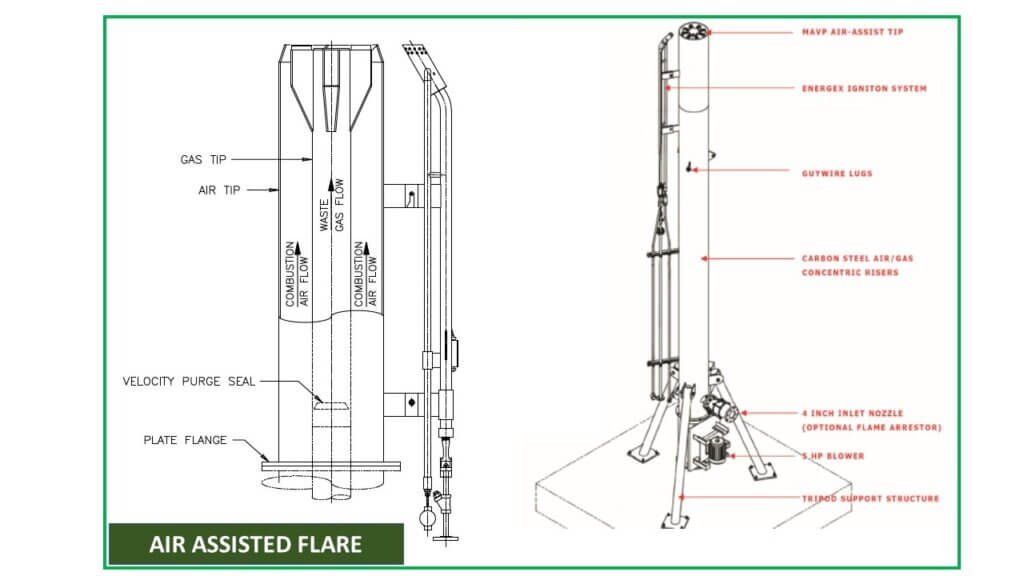
Pressure-Assisted Flares
Pressure-assisted flares use the vent stream pressure to promote mixing at the burner tip. If sufficient vent stream pressure is available, these flares can be applied to streams previously requiring steam or air assist for smokeless operation. Pressure-assisted flares generally (but not necessarily) have the burner arrangement at ground level, and consequently, must be located in a remote area of the plant where there is plenty of space available. They have multiple burner heads that are staged to operate based on the quantity of gas being released. The size, design, number, and group arrangement of the burner heads depend on the vent gas characteristics. Below are some types of pressure assisted flare
Non-Assisted Flares
The non-assisted flare is just a flare tip without any auxiliary provision for enhancing the mixing of air into its flame. Its use is limited essentially to gas streams that have a low heat content and a low carbon/hydrogen ratio that burn readily without producing smoke. These streams require less air for complete combustion, have lower combustion temperatures that minimize cracking reactions, and are more resistant to cracking.
